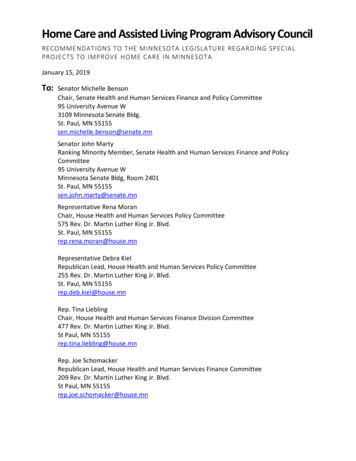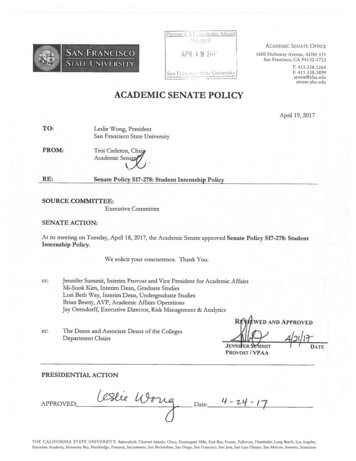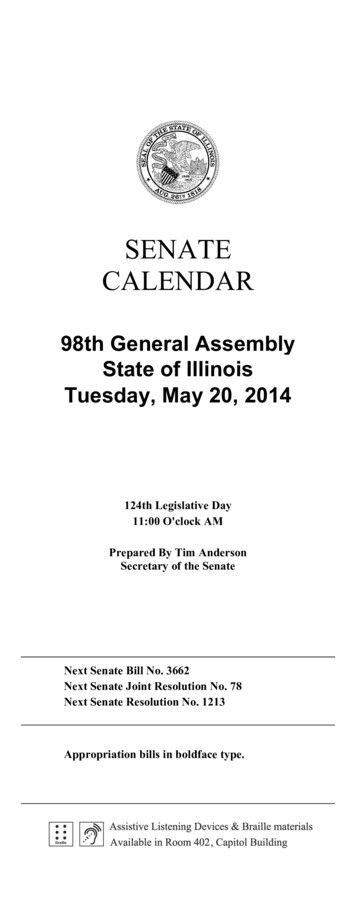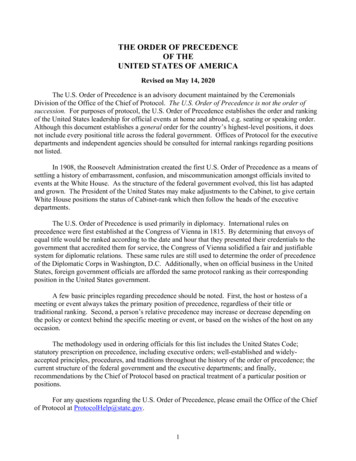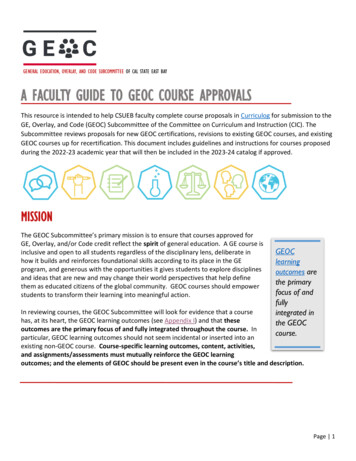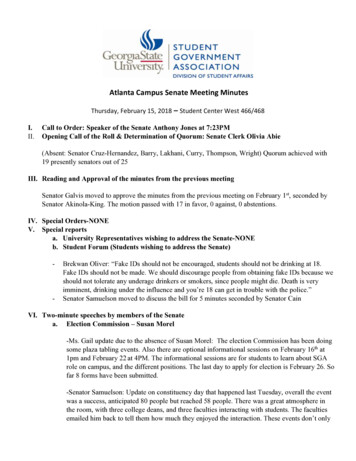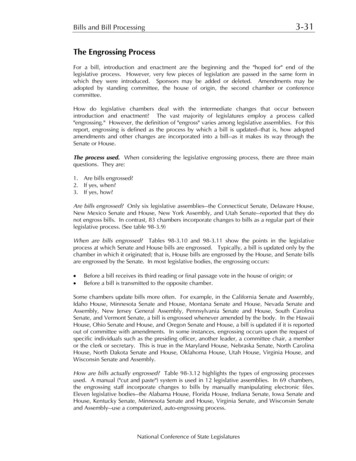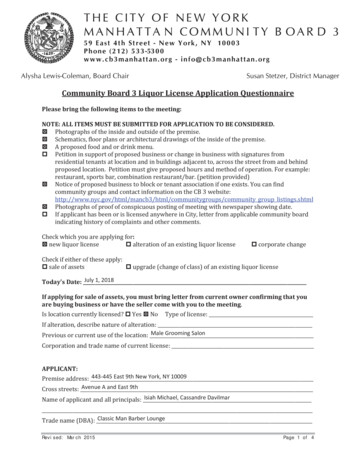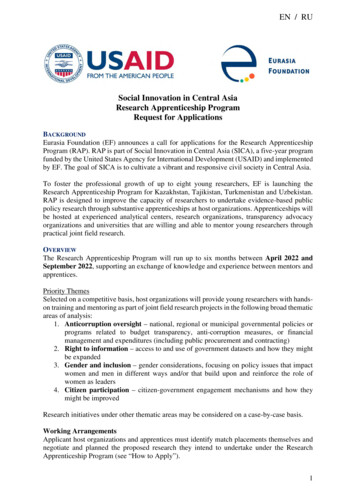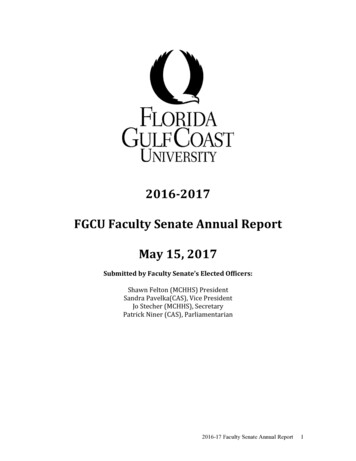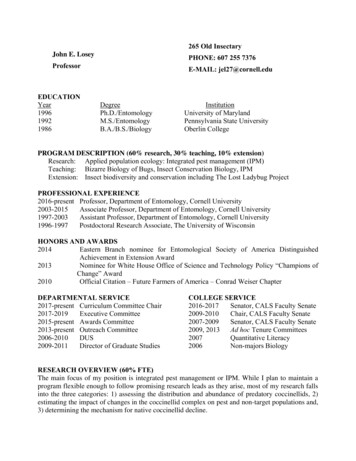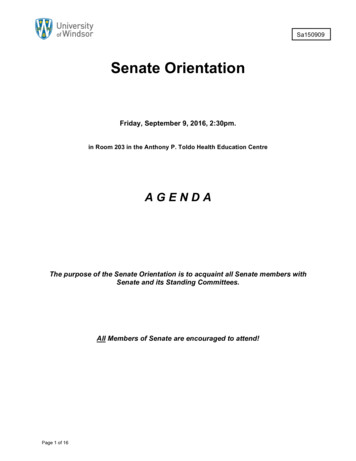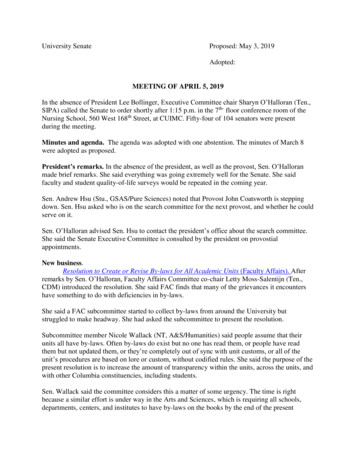
Transcription
University SenateProposed: May 3, 2019Adopted:MEETING OF APRIL 5, 2019In the absence of President Lee Bollinger, Executive Committee chair Sharyn O’Halloran (Ten.,SIPA) called the Senate to order shortly after 1:15 p.m. in the 7th- floor conference room of theNursing School, 560 West 168th Street, at CUIMC. Fifty-four of 104 senators were presentduring the meeting.Minutes and agenda. The agenda was adopted with one abstention. The minutes of March 8were adopted as proposed.President’s remarks. In the absence of the president, as well as the provost, Sen. O’Halloranmade brief remarks. She said everything was going extremely well for the Senate. She saidfaculty and student quality-of-life surveys would be repeated in the coming year.Sen. Andrew Hsu (Stu., GSAS/Pure Sciences) noted that Provost John Coatsworth is steppingdown. Sen. Hsu asked who is on the search committee for the next provost, and whether he couldserve on it.Sen. O’Halloran advised Sen. Hsu to contact the president’s office about the search committee.She said the Senate Executive Committee is consulted by the president on provostialappointments.New business.Resolution to Create or Revise By-laws for All Academic Units (Faculty Affairs). Afterremarks by Sen. O’Halloran, Faculty Affairs Committee co-chair Letty Moss-Salentijn (Ten.,CDM) introduced the resolution. She said FAC finds that many of the grievances it encountershave something to do with deficiencies in by-laws.She said a FAC subcommittee started to collect by-laws from around the University butstruggled to make headway. She had asked the subcommittee to present the resolution.Subcommittee member Nicole Wallack (NT, A&S/Humanities) said people assume that theirunits all have by-laws. Often by-laws do exist but no one has read them, or people have readthem but not updated them, or they’re completely out of sync with unit customs, or all of theunit’s procedures are based on lore or custom, without codified rules. She said the purpose of thepresent resolution is to increase the amount of transparency within the units, across the units, andwith other Columbia constituencies, including students.Sen. Wallack said the committee considers this a matter of some urgency. The time is rightbecause a similar effort is under way in the Arts and Sciences, which is requiring all schools,departments, centers, and institutes to have by-laws on the books by the end of the present
Senate minutes, April 5, 2019/page 2 of 11academic year. She said that in another role, she was co-chair of an A&S lecturers’ committee,which strove to understand the status of non-tenure-eligible faculty on renewable contracts invarious departments. When that group asked about by-laws, the answers were often unclear.Sen. Wallack concluded that everyone seemed to agree that by-laws are a good thing to have, soFAC was asking to put this resolution to a swift vote to get this process underway and develop aquick timeline for delivery, because if this turns into another years-long effort, units will likelyrevert to custom, which could lead to institutional and governmental stagnation.Sen. Hsu asked how the resolution would be enforced. Would units be compelled to produce bylaws?Sen. Wallack doubted that anyone could be compelled to do anything in particular. She said partof the point of this effort is just to make by-laws visible. She did not have a shaming protocol inmind, but also thought it was important to make it known which units have decided not toproduce public by-laws.Sen. O’Halloran said the provost has collected by-laws from a number of units, and in a shorttime all A&S units will have them. If some unit failed to update by-laws, she would be preparedto mention that the unit had not complied, though she would prefer not to. But her sense was thatnotice of that sort would come from Faculty Affairs. She thought there were better ways thanshaming to secure compliance, but she thought units would be enforcing these guidelines, whichare required by the Provost.Sen. David Bickers (Ten., P&S) called for developing a shared template that could serve as ablueprint, particularly because of the heterogeneity of the University’s organizations. Withoutsuch a template, he said, the project could be chaotic. He suggested that leaders of this effortshould assemble a small group of people well versed in organizational structures to think aboutthis challenge, and make it possible to have worthwhile, consistent results.Sen. Moss-Salentjin said both of these first two comments raised important questions for FAC toaddress. In fact, FAC planned to follow up on the present resolution with just what Sen. Bickerswas requesting—some idea of what by-laws should include.To the earlier question, she replied that FAC was not willing to shame units, but it couldprofusely thank those who have submitted by-laws, and look forward to receiving the rest. Shesaid she would be happy to do that at every plenary.Sen. Richard Smiley (Ten., P&S) said he had been shocked by the lack of by-laws in somegrievance investigations he had participated in for Faculty Affairs. He wholeheartedly supportedthe resolution, and also understood why it was presented in general, preliminary terms—toenable people to start the search for by-laws early, perhaps over the summer. He had twoquestions:1) Who takes responsibility for collecting these by-laws? Is it Faculty Affairs or some othercommittee?
Senate minutes, April 5, 2019/page 3 of 112) Who will take charge of creating a template for by-laws? Will this require a secondresolution? He said someone should take on this assignment.Sen. Moss-Salentjin said FAC planned at first to provide a second resolution with the veryelements that senators were asking for. But the committee found that the A&S template includedmost of the key ingredients. So FAC would be asking for something like a parallel document.She said by-laws are generally understood to be supplied to the Provost’s Office. FAC would askto receive this information, to post on a Senate web site that everyone could consult.Sen. Mike Ford (Stu., GSAS/Humanities) asked what the resolution meant by calling for by-lawsrevisions “at regular intervals.” That could mean enormous regular intervals. Could it call forfrequent regular intervals?Sen. Moss-Salentjin took the point, but added that FAC did not want to put too much pressure onunits. Sometimes an inspection may show that by-laws working, and changes are not needed.She said the committee at first thought of an interval of five or ten years between by-lawsreviews. If by-laws seem adequate after five years, perhaps that interval could be extended to 10years. Another useful provision would be to date any set of by-laws posted on the web site.Sen. Wallack explained that the committee at first sought a resolution that directly addressed thecontent of by-laws. But it realized that it needed a more fundamental agreement—that suchdocuments should exist. So a list of the types of procedures to be included in a set of by-lawswill be part of a second resolution, to be presented in the fall. In the meantime she would becontent with a quick Senate vote.Sen. Susan Bernofsky (Ten., Arts) said there is now debate in her School about whether theprocess of revising by-laws should include deans or be entirely driven by faculty. She asked ifFAC had any recommendations for resolving this disagreement.Sen. Wallack said FAC could imagine offering advice on that kind of issue after there wasagreement to have by-laws. She said that if the Senate were prepared to agree in that way, thenthe committee would take up queries like Sen. Bernofsky’s as it worked on a template document.She anticipated many variances based on particular governance structures and types of leaders,and said FAC would be open to helping any unit in establish its by-laws.Sen. O’Halloran said the School of the Arts now has a set of by-laws, including a provision forratification by faculty. The procedural part is how their particular ratification process works.Senate vote. Sen. Moss-Salentjin asked for a vote on the resolution. Sen. O’Halloranasked for and received a motion and a second to call the question. The Senate then voted in favorof the resolution, without dissent, but with one abstention.Resolution to Approve an Advanced Certificate Program for Pediatric Acute Care NursePractitioners (Education). Sen. O’Halloran said the Senate doesn’t usually consider certificates,
Senate minutes, April 5, 2019/page 4 of 11but Nursing School certificate programs require New York State approval, so Senate approval isnecessary.Sen. James Applegate (Ten., A&S/Pure Sciences, and co-chair of Education), said he and Sen.Michael Sutton (Stu., SEAS/Grad), a Ph.D. candidate in biomedical engineering, evaluated theproposal. The proposed certificate program requires 20-24 points, about two-thirds of therequirement for a master’s degree, and it is a requirement for one of the pediatric specialties inthe Doctor of Nursing Practice program.Sen. Sutton said more children in the U.S. are now living longer with complex, chronic illnessesthat in the past, and this means an increased need for practitioners who can take care of thesechildren in both acute and primary care settings. This specialty was developed largely by ActingDean of Nursing Judy Honig.The original plan was to develop a track for this specialty in the Nursing School. But New YorkState does not allow tracks in nursing programs, so the decision was made to pursue an advancedcertificate instead. It requires ten courses totaling 25 points, which exceeds both Columbia andNew York State requirements. Six of the ten courses in the proposed program are new and thereare faculty ready to teach them. The program includes 500 hours of clinical work, which is arequirement of the state certification board. Sen. Sutton said the program would require only fourto six additional courses during the last couple of semesters.Sen. Mary Mundinger (Ten., Nursing) said the proposed program does three things for Nursingfaculty and students. It reestablishes an acute care curriculum in pediatric care. With the supportcourses already in place, the 25 clinical credits in the certificate program would enable a studentto become an acute care nurse practitioner in pediatrics. A second benefit is that the programwould allow existing nurse practitioners to meet the market demand and add the acute carecredential to the primary care credential they may already have. Acute care is probably thelargest market now in pediatric nursing. The third benefit of the new certificate is that it enablesthe Doctor of Nursing Practice program to fulfill another portion of its founding mission to trainnurses to care for patients across settings.Senate vote. Sen. O’Halloran asked for and received a motion and a second to move to a vote.The Senate then voted unanimously to approve the resolution.Committee reports.Campus Planning and Physical Development. Committee chair John Donaldson (Ten.,Bus.) introduced the report. He said the committee became aware in the spring of 2018 ofdissatisfaction among researchers with the facilities in some of the main buildings at the MedicalCenter. The committee began an investigation and asked for a report from the ColumbiaUniversity Postdoctoral Society (CUPS), a synopsis of which Associate Research ScientistRegina Martuscello, one of the authors, would present in a moment.Sen. Donaldson said CPPD members, after seeing the report, began holding fruitful meetingswith Medical Center leaders. These discussions convinced the committee that the problemsresulted mainly from organizational, governance and ownership issues involving space on the
Senate minutes, April 5, 2019/page 5 of 11Medical School campus, especially those associated with the New York Brain Bank. Sen.Donaldson said Sen. Julie Yoshimachi (Stu., Nursing) would explain those organizational issuesand current attempts to address them. Sen. Donaldson said he was pleased to report that facilitiesleadership at CUIMC has already begun to implement solutions. He acknowledged the difficultyof maintaining old Medical Center buildings. He said the important issue is how these problemsare addressed, and the committee was encouraged by the cooperation it had received fromfacilities leaders at CUIMC. He said the committee’s project was ending on a positive note, andthe committee hoped to be involved in subsequent efforts on the medical campus.Dr. Martuscello then summarized five main problems identified in a report that she hadpresented last fall to the Senate Campus Planning Committee: water leaks and flooding;temperature inconsistencies, specifically ambient or room temperature; electrical disruptions,surges and shutoffs; noise levels and their effects on animal cohorts; and complications indetermining who is ultimately responsible for spaces shared by New York Presbyterian Hospitaland CUIMC.In the course of Dr. Martuscello’s account of a freezer that malfunctioned in a lab in the fall of2017, Sen. Andrew Marks (Ten., P&S) asked if the freezer had an alarm.Dr. Martuscello said it did not have a back-up alarm. The freezer now has an alarm. In any case,she said, the compressor exploded and the machine just turned off. So even a backup alarmsystem would not have been activated in this case.Sen. Marks and Dr. Martuscello continued their conversation, but it was mainly inaudible on therecording.Sen. Yoshimachi focused on the last issue that Dr. Martuscello had raised—dividedresponsibility for facilities between Columbia and NYP. Each institution owns some of thebuildings, and each has its own facilities operations. And in some buildings, each institutionowns some of the floors. In some cases, Columbia owns the space and provides the staff, butNYP supplies the heating.Sen. Yoshimachi said the Senate group is trying to understand these complexities better. Is themaintenance staff unclear about who is in charge of what? Are there communication issues thecommittee should look into?Sen. Yoshimachi said Campus Planning wants to understand how much this complicatedsituation has affected clinical work and research. What changes can be made to mitigate thissituation going forward? One crucial question, raised by Dr. Martuscello, is how many majorcontracts and grants funding these research projects will be lost. And more generally, how muchproductive time must be lost?Sen. Yoshimachi said Facilities at the Medical Center had been extremely helpful, answeringmany questions and meeting with committee members. She was excited to hear that manychanges were in progress, both long-term and short-term. In the past staff were not assigned
Senate minutes, April 5, 2019/page 6 of 11responsibility for particular buildings and sections of the Medical Center, but now they are. Sen.Yoshimachi hoped that this change would make a difference.Finally, Sen. Yoshimachi said, the committee hoped to learn more about the New YorkPresbyterian side of the divide, and to continue to work closely with CUIMC Facilities people.Sen. O’Halloran welcomed Donna Lynne, Chief Operating Officer of CUIMC.Ms. Lynne introduced herself to the Senate. She identified herself as a graduate of the School ofPublic Health, where she had also served as an adjunct faculty member for the last 14 years. Butshe had been COO for only two and a half months. She said Senior Vice President for FacilitiesManagement Amador Centeno, standing beside her, had been at CUIMC much longer. So hadPatrick Thompsen, Assistant Vice President for Facilities Engineering, who also stood at thefront of the room. Ms. Lynne affirmed her commitment to addressing the facilities issues raisedin the committee’s report.She said Dean Lee Goldman was out of town, but otherwise would have attended this meeting.She stressed that patient care and research issues have a high priority in CUIMC facilitiesoperations. She said overlapping jurisdictions with NYP can complicate operations, but CUIMCalso has a strong working relationship with NYP.She said the Brain Bank itself is funded by the National Institutes of Health, but CUIMC alsosubsidizes it significantly through the departments. It has a number of research functions,supporting Alzheimer’s research and many other kinds. She said CUIMC Facilities was willingto consider having a stronger relationship with the committee, and she had met with Sen.Donaldson and Vice Chair Patrice Derrington (NT, GSAPP) in February. She submitted a formalresponse to them, and also committed to provide better notice of when construction would beoccurring. She was willing to include NYP in discussions and to make sure they are aware of thesensitivity of some of the research activities. She agreed that some of the buildings are old, andproblems arise, but said her people try to respond as well as they can.Mr. Centeno added that when his team designs spaces, it works with the departments to supplywhat the space requires. But over time things change, and as more equipment comes in, theinfrastructure in the room at some point is no longer able to support additional freezers and otherequipment. So there has to be a collaboration between the departments and Facilities, becausethere are some four million square feet of space at CUIMC. If there is insufficientcommunication with Facilities about additional electrical power, the systems will not support it.Mr. Centeno said he does not have direct oversight of hospital space, which is more complicated.He does have a good relationship with his counterpart at the hospital, and they do communicate,but unless a problem gets escalated to him personally, he may not know what is going on. Hesaid Columbia leases about 800,000 square feet of space from the hospital. So when somethingescalates, Mr. Centeno may hear from a departmental administrator that the hospital is not beingresponsive, and then he takes up that issue with his counterpart to try to resolve it. Because it’scomplicated and the lines are blurred as to who owns what, he tries to provide as much
Senate minutes, April 5, 2019/page 7 of 11communication as possible, posting relevant information on the website, and providing advancenotice of upcoming projects.Sen. Marks said the issue with the freezers is critically important. He asked if there could be apolicy that any new freezer must have a battery-operated back-up alarm that is independent ofthe circuit. He also recommended having a survey of all the existing freezers to make sure thatthey’re not overloading the electrical system and that all the freezers have backups, because thiskind of loss can be devastating. He said these actions seemed to him like easy fixes.Mr. Centeno replied that there isn’t a policy, but there are about 800 freezers on the medicalcampus. He had considered various monitoring systems, and there are some emergency freezerson board now. He had recommended having a policy, but departments haven’t been mandated tocarry it out. When new recruits come in and his team starts designing their spaces, and theyannounce that there are freezers, he urges them to put in monitoring systems, and they normallydo. But there is no mandate to monitor existing freezers on campus.Sen. Marks said he had been through this process many times, and he thought at the end of theday that monitoring should be a requirement, despite the additional cost.He and Mr. Centeno did not recall what the additional cost was.Dr. Martuscello said she did not know what it would cost to protect all freezers at CUIMC, butan individual alarm system would cost about 1,800.Sen. O’Halloran suggested that insurance policies for each lab should bring the costs down.Mr. Centeno said there are insurance policies across the University, and Risk Management hastaken part in this discussion as well.Sen. O’Halloran suggested that there might be a way to incentivize instead of mandate.Ms. Lynne said her experience in the insurance business—not liability but health insurance—taught her there is an actuarial assessment of the likelihood that a freezer will fail. She suggestedraising this question with Risk Management.Sen. Greg Freyer (NT, Public Health) said he had been on the Medical Campus more than 30years. He had had labs in Vanderbilt Clinic, Hammer, and Black. He said most of that space ispretty bad, except for Hammer. He thought the greatest source of frustration for faculty anddepartments is the millions of dollars that they pay for their space. His department,Environmental Sciences, pays around 1.3 million a year. He explained to senators fromMorningside that people at CUIMC actually pay for their space. That space doesn’t have to bebeautiful, but in fact it’s often not even functional. He said it is also extraordinary to him thateach lab has to provide its own alarm system. He said he was just expressing the acute frustrationthat many of his colleagues feel over having to pay for space, which never made sense to him.Departments didn’t pay for space in the past, as when he arrived at Columbia. Paying for spacewas something implemented by Dean Goldman since his arrival in 2007.
Senate minutes, April 5, 2019/page 8 of 11Sen. Jacqueline de Vegvar (Stu., P&S), following up on Sen. Freyer’s remarks, asked Mr.Centeno to say a little more about how space is treated at the Medical Center, and why thearrangement was changed to require departments to pay for their own space. What is the utilityof that arrangement compared to the old one?Mr. Centeno outlined the genesis of the rent model for space. He said that when Dr. Goldmanwas hired as dean, the Medical Center had an annual deficit approaching 50 million. DeanGoldman changed the funding model to socialize the cost of running the central units—IT,Facilities, Human Resources—by establishing a space rate, and requiring departments to pay fortheir space. The intent was to make academic units more aware of the space, so that they wouldonly take space they could support by generating the necessary clinical or research revenue. Thisapproach would incentivize departments to give back space that they could not use efficiently.This system has now been in place for 12 years.Ms. Lynne added that as Columbia grows as a medical center and as a university, it has to payfor new space through rent to NYP, with the ancillary costs that Mr. Centeno had mentioned, orit goes out to get new space. So if space is not being used efficiently, it behooves a departmentnot to spend the additional money and increase its costs, whether it’s tuition or something else,and to make more efficient use of the space it already has. With all due respect, she added thatsomeone running a business knows that space is not free.Sen. de Vegvar asked how, under those conditions, students can get common space. She saidstudents are trying to work together to build a university, to get to know each other, to shareideas. How to balance those priorities on the medical campus?Mr. Centeno said each school on the medical campus has assigned, socialized space as part of itsportfolio. The schools pay for the space, but it’s free to students.Sen. de Vegvar said there is no common space on the medical campus aside from the 11th floorof Bard Hall.Mr. Centeno said half of the space in the new Vagelos education building is common space,socialized space.Sen. de Vegvar said she was talking about common space for all uptown students, not just forthose in a particular school. She said she was asking about the pros and cons of a creating adifferent model of space. And if people are paying for space, are they getting what they pay for?She said Sen. Freyer was pointing out that the facilities are not up to par.Mr. Centeno said deans of students are charged with outlining the space requirements for theirstudent populations. He said there seemed to be a misconception about access to differentbuildings. Some people say that only P&S students have access to the Vagelos building. Theclassrooms are reserved for P&S, but the social spaces are open to anybody with a CUID.
Senate minutes, April 5, 2019/page 9 of 11Sen. de Vegvar said those spaces are not open to all students, and they’re not non-reservable, soat any point the space can be reserved by faculty or some other priority group. But then it’s nolonger a student space.Mr. Centeno said he was pleased that Sen. de Vegvar and other Medical Center senators wouldbe meeting with deans of students at the end of the month to discuss this subject. He said thedeans of students really own the dissemination of student space, and they’re the people to talk to.Sen. O’Halloran suggested continuing this conversation offline. She said similar issues came upon the Morningside campus in 2010 when the Senate discussed a space in Philosophy Hall wheregraduate students could interact. The results were highly successful and might provide a usefulmodel now.Student Affairs.Report on food insecurity. Sen. Jonathan Criswell (Stu., GS) characterized food insecurity as asignificant problem on American college campuses, including Columbia’s. He said that agrowing student volunteer and fund-raising effort to address the problem in recent years hasestablished a food pantry (the only one of its kind in the Ivy League), but that it is time toinstitutionalize the enterprise with consistent and sufficient funding (perhaps in the form ofsupplementary financial aid) and regular publicity and administrative oversight. He said therehas been progress toward an agreement on a satellite food pantry at CUIMC.Sen. Shelley Saltzman (NT, SPS) said she teaches many GS students in the American LanguageProgram. Many are immigrants and don’t know about the Food Pantry, which she praised as awonderful service. She suggested that in addition to the once-a-semester email blast that Sen.Criswell had called for in his report, there could be a daily notice about the food pantry on themonitors in the Lewisohn lobby that publicize psychological and other services.Sen. Criswell said he thought this was a fantastic idea that would be very helpful to GS students.But he also wanted to expand awareness of the food pantry to all Columbia schools, graduate andundergraduate. Students from every school (with one exception) have used the food pantry atsome point, because they’re low-income or because they are from abroad with scant resources inthis country, or for another reason. Sen. Criswell said the food pantry is truly a resource for all ofColumbia, not just GS.Sen. Nicole Wallack (NT, A&S/Humanities) said she directs the Undergraduate WritingProgram, where the Writing Center is located. She wondered if committees on instruction couldput a line on syllabi about the food pantry, along with notices of other student services. She saidthis seems like a crucial priority, and the notice would appear in a guaranteed place on everystudent syllabus.Sen. Criswell said this also sounded like a great idea. He welcomed a chance to talk more aboutit offline. He said expanding the ideas and efforts of a few senators and student volunteers toinclude administrators and faculty and staff would be a vital gain.
Senate minutes, April 5, 2019/page 10 of 11Sen. Susan Bernofsky (Ten., Arts) said she was a bit shocked to hear that the food pantry andrelated efforts were not yet receiving financial support from the University administration. Sheasked what financial support the group was receiving.Sen. Criswell said he works closely with the board of the food pantry, but is not a member. Hisunderstanding was that the fundraising is conducted entirely by students. They are trying to workwith deans and other administrators to get them involved in addressing food insecurity, which isbasically a financial aid issue. He said everyone should come together to address these issues.Sen. Eric Tang (Stu., Law) said he was struck, as a current student and one who had also gottenhis undergraduate degree here, by the amount of food wasted on the Columbia campus. Heoffered food for thought (pun intended), inviting people to think about ways to reduce foodwaste. For example, at school events where there’s too much food, students could send out anemail or a Twitter message alerting other students.Sen. Criswell said some undergraduate schools have a Facebook page where students canannounce extra food in this way. And there are efforts to arrange for students who have extrameal swipes at the dining hall to pass them on to other students. Some progress has certainlybeen made over the past two or three years. But again, students need partners in these efforts.Sen. Mike Ford (Stu., GSAS/Humanities) said there’s a liability issue with prepared food, andthe food pantry needs certification to handle prepared food, as opposed to preserved food. So thefood pantry cannot collect and distribute leftover food. He also asked whether students are alsoseeking outside funding, perhaps in the form of an endowment. He estimated that an endowmentof 150,000 could provide 10,000 in annual support in perpetuity.Sen. Criswell said that a partnership with the New York Food Bank expanding students’ capacityto stock the food pantry came about through such an effort. And students are continuing to lookfor other partners inside and outside the University to help institutionalize their work.Sen. Michael Sutton (Stu., SEAS/Grad) said most if not all schools hold an orientation at thestart of each school year. He was confident that Engineering grad students, for example, wouldsupport a five-to-ten-minute presentation on the food pantry during that event.Sen. Criswell welcomed the suggestion.Sen. Joel Krejmas (Stu., CDM) asked for an update on plans for a satellite food pantry at theMedical Center.Sen. Criswell understood that plans for such a food pantry are nearly set. He was not ready tomake a formal announcement, but he did expect one to be made soon through the food pantry.He said this was a student initiative in the Senate.Sen. Julie Y
to become an acute care nurse practitioner in pediatrics. A second benefit is that the program would allow existing nurse practitioners to meet the market demand and add the acute care credential to the primary care credential they may already have. Acute care is probably the largest market now in pediatric nursing.
